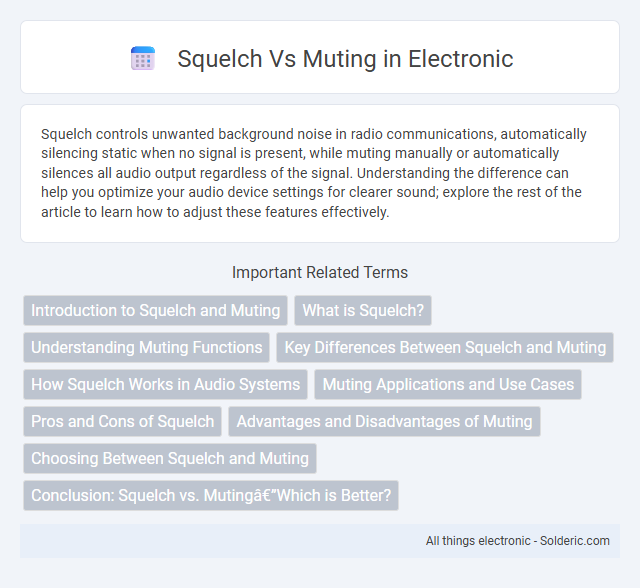Squelch controls unwanted background noise in radio communications, automatically silencing static when no signal is present, while muting manually or automatically silences all audio output regardless of the signal. Understanding the difference can help you optimize your audio device settings for clearer sound; explore the rest of the article to learn how to adjust these features effectively.
Comparison Table
| Feature | Squelch | Muting |
|---|---|---|
| Purpose | Eliminates background noise when no signal is present | Silences audio output manually or automatically |
| Function | Automatically blocks weak or unwanted signals | Stops audio transmission or playback |
| Application | Used in radios, communication devices, and receivers | Used in audio devices, media players, and communication apps |
| Control Type | Automatic or adjustable threshold based on signal strength | Manual toggle or button |
| Effect on Audio | Mutes noise but allows strong signals to pass | Completely silences audio output |
| Typical Use Case | Preventing static and noise on radio channels | Temporary silencing of audio during calls or media playback |
Introduction to Squelch and Muting
Squelch is a radio signal-processing function that suppresses the audio output of a receiver in the absence of a sufficiently strong input signal, effectively filtering out background noise and static. Muting, on the other hand, is a user-controlled feature that temporarily silences the audio output regardless of signal strength, often used to block unwanted sounds or commercial interruptions. Both squelch and muting improve listening experience but operate through distinct mechanisms tied to signal detection and manual audio control.
What is Squelch?
Squelch is a signal processing function in radios that suppresses background noise by muting the audio output when the received signal is below a certain threshold. It allows users to avoid hearing static or weak signals, ensuring clearer communication by only unmuting when a strong, valid transmission is detected. This differs from manual muting, which is user-controlled and does not depend on signal strength or quality.
Understanding Muting Functions
Muting functions temporarily silence audio without altering signal strength, allowing you to pause sound instantly while maintaining ongoing input. Unlike squelch, which filters out unwanted background noise by setting a threshold for audio signal activation, muting ensures complete silence with no signal modification. Your control over muting helps manage audio clarity during calls, broadcasts, or recordings by instantly stopping sound transmission.
Key Differences Between Squelch and Muting
Squelch primarily controls the audio output by suppressing background noise or static in radio communication, activating only when the signal exceeds a set threshold, whereas muting completely silences the audio regardless of incoming signals. Squelch is dynamic, automatically adjusting based on signal strength to improve clarity, while muting is a manual or preset function that stops all sound transmission. The key difference lies in squelch's noise-filtering capability compared to muting's total audio cutoff.
How Squelch Works in Audio Systems
Squelch in audio systems automatically suppresses background noise and weak signals by setting a threshold level, allowing only signals above that level to be heard. This feature improves sound clarity by filtering out static or unwanted transmissions, unlike muting which simply silences all audio regardless of signal strength. Understanding how squelch works empowers you to fine-tune your communication equipment for optimal audio quality.
Muting Applications and Use Cases
Muting applications temporarily silences audio output without altering signal strength, ideal for managing distractions during meetings or multimedia playback. This feature allows you to control sound on demand, ensuring privacy or focus in shared environments. Muting is essential in scenarios like conference calls, where maintaining silence when not speaking prevents background noise interference.
Pros and Cons of Squelch
Squelch effectively eliminates audio noise in radio receivers by suppressing background static when no transmission is present, enhancing signal clarity and reducing listener fatigue. However, squelch may delay the reception of weak signals or cause brief audio cutoffs during fluctuating transmissions, which can result in missed information. Its automatic noise filtering benefits must be balanced against potential communication gaps in low-signal environments.
Advantages and Disadvantages of Muting
Muting offers the advantage of completely silencing unwanted audio signals, ensuring no sound passes through, which is ideal for moments requiring absolute silence. However, it can lead to abrupt audio cutoffs that may feel unnatural and disrupt the listening experience by eliminating background noise that could provide context. Your choice between muting and squelch depends on whether seamless audio transitions or total silence better suit your needs.
Choosing Between Squelch and Muting
Choosing between squelch and muting depends on the context of your audio setup; squelch automatically filters out background noise below a certain threshold, ideal for radio communications, while muting manually silences the audio output, giving you full control over when sound is heard. Understanding the sensitivity settings of squelch can prevent unwanted static without cutting essential audio, whereas muting is effective for temporary silencing without adjusting signal processing. Your choice should align with whether you prefer automated noise suppression or direct control over your audio stream.
Conclusion: Squelch vs. Muting—Which is Better?
Squelch and muting serve different purposes in audio control, with squelch automatically reducing background noise in radio communications, while muting manually silences audio output. Your choice depends on the context: squelch is ideal for maintaining clear reception without constant adjustments, whereas muting provides direct control when immediate silence is needed. For ongoing signal clarity, squelch is generally more effective, but for precise audio management, muting offers better flexibility.
Squelch vs muting Infographic

 solderic.com
solderic.com